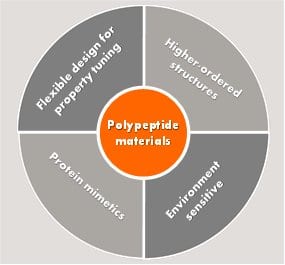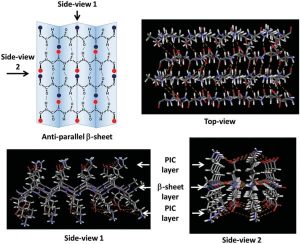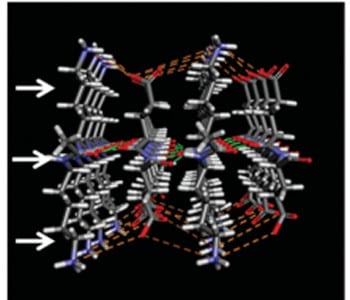 Polypeptides are highly interesting materials, the properties of which are based on the well-controlled structure and the diversity of the constituent amino acid monomers. Additionally, these materials are inherently biocompatible and environmentally friendly. Understanding and manipulating their behavior is important in various fields, ranging from biotechnology (biomaterials, drug delivery systems, tissue engineering, sensors, and molecular devices) to fundamental studies (protein-protein interactions, molecular selective events).
Polypeptides are highly interesting materials, the properties of which are based on the well-controlled structure and the diversity of the constituent amino acid monomers. Additionally, these materials are inherently biocompatible and environmentally friendly. Understanding and manipulating their behavior is important in various fields, ranging from biotechnology (biomaterials, drug delivery systems, tissue engineering, sensors, and molecular devices) to fundamental studies (protein-protein interactions, molecular selective events).
In particular, self-assembly formation from oppositely charged polypeptides via non-covalent interactions, e.g., electrostatic interaction, is very important to develop higher-ordered structures from polypeptides, as electrostatic interactions are frequently found in biosystems to form hierarchical structures like protein superstructures. Nonetheless, in spite of the simple principle of electrostatic interaction, revealing the factors that govern the resulting higher-ordered structure is still a challenging issue even today. Moreover, self-assemblies via electrostatic interaction can be achieved using a simple method: just mixing of aqueous solutions of oppositely charged materials. That is advantageous and attractive from the technical and engineering point of view.
 Japanese researchers around Kazunori Kataoka (University of Tokyo) and Akihiro Kishimura (Kyushu University) have now succeeded in the control of higher-ordered structure of the electrostatic assembly prepared from oppositely charged polypeptides, poly-L-lysine and poly-L-glutamate, in a unique manner. They specifically obtained molecular assemblies possessing β-sheet structures, although poly-L-lysine and poly-L-glutamate are typically known to form a-helix structure. Notably, for the β-sheet formation, the electrostatically interacted part should be isolated from the aqueous medium by the layer of non-ionic hydrophilic segment, polyethylene glycol (PEG), which was covalently linked to a terminus of a polyglutamate chain. Without PEG chains, the resulting assembly did not form any higher-ordered structure. Thus, site-specifically attached non-ionic polymer chains like PEG are helpful for modulation of the environment for electrostatic assembly formation.
Japanese researchers around Kazunori Kataoka (University of Tokyo) and Akihiro Kishimura (Kyushu University) have now succeeded in the control of higher-ordered structure of the electrostatic assembly prepared from oppositely charged polypeptides, poly-L-lysine and poly-L-glutamate, in a unique manner. They specifically obtained molecular assemblies possessing β-sheet structures, although poly-L-lysine and poly-L-glutamate are typically known to form a-helix structure. Notably, for the β-sheet formation, the electrostatically interacted part should be isolated from the aqueous medium by the layer of non-ionic hydrophilic segment, polyethylene glycol (PEG), which was covalently linked to a terminus of a polyglutamate chain. Without PEG chains, the resulting assembly did not form any higher-ordered structure. Thus, site-specifically attached non-ionic polymer chains like PEG are helpful for modulation of the environment for electrostatic assembly formation.
These findings may help us to understand the formation mechanism of biomacromolecular assemblies in biosystems, and be beneficial for the design of environment-sensitive smart materials.

















